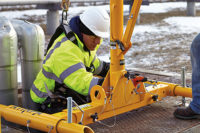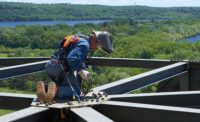According to OSHA, roughly 60 percent of deaths in confined spaces are from physical hazards including “struck by,” “caught in,” “collapses” and “falls.” At least another 30 percent are atmospheric hazards, including fires. Such hazards can be standalone events, but often occur in combination with other confined space hazards. Knowing what to do – and having a plan in place – can mean the difference between life and death.
Picture this scenario: A coworker is passed out in a 20-foot deep holding tank. He is unresponsive and needs to be extracted immediately. Do you dial 911 and wait for a rescue crew to respond? Can you pull him out? If you have to go in and rescue him, do you have the training and equipment to do so? What do you do?
This article examines safety and rescue options for a dangerous and all-too-common scenario—someone in a confined space who needs immediate rescue.
Setting the scene
Many workers and employers may not be clear on exactly what confined spaces actually are or what hazards may lurk inside a confined space. Everything from tanks and tunnels to manholes and silos can be considered confined spaces. OSHA maintains that confined spaces exist in many industries and that workers frequently come into contact with one during the course of their work. If a space is difficult to get in and out of, large enough to physically enter but not designated for regular occupancy, odds are it’s a confined space.
To make sure you understand the space and its potential hazards, it’s important to conduct an adequate risk assessment before entering the space. The employer must understand the possible hazards and have a plan in place to address them.
Understanding confined space dangers and types
Even if hazards are not immediately apparent or present, they can arise while workers are in a confined space. Common hazards include:
• Lack of oxygen
• Toxic gas, fume or vapor
• Liquids and solids that can fill a confined space, or release gases into it when disturbed
• Fire and explosions
• Residues left behind that can give off gas or vapor
• Dust
• Heat, either naturally occurring or as a result of work activities in the space
• Activities outside the space such as a change in air quality
• Physical configuration of the space
There are two types of confined spaces as designated by OSHA in 29 CFR 1910.146. Non-permit required confined spaces are spaces that do not have the potential to contain any hazard capable of causing death or serious physical harm. Permit-required confined spaces, on the other hand, have one or more of the following characteristics:
1. A hazardous atmosphere or the potential for one
2. Material, such as grain, that could potentially engulf an individual
3. Walls converging inward or floors sloping downward and tapering into a smaller area that could trap or asphyxiate an individual
4. Any other recognized safety or health hazard, such as unguarded machinery, heat stress or a fall hazard
Recognizing the type of confined space is only the first step in addressing worker safety. Depending on the designation of the space, proper safety precautions including but not limited to atmospheric testing, worker training, communications/observation and rescue procedures are required. With an adequate understanding of the space, as well as planning, preparation and practice, along with proper equipment, employers can keep employees safe while working in and around confined spaces.
Let’s consider four potential scenarios and rescue responses.
Scenario one: self-rescue
In an ideal situation, the danger is detected and action taken before it becomes life-threatening, allowing the at-risk worker to rescue him- or herself.
Self-rescue is the most effective and safest form of rescue. An example of an opportunity to employ self-rescue occurs when an attendant or the entrant is continuously monitoring the atmosphere in the confined space and recording the results. When the attendant or entrant notices that the air quality is decreasing rapidly and evacuation is necessary, the entrant is alerted to the increasing hazards and can exit the space safely.
Scenario two: non-entry rescue
If the conditions in a confined space have become hazardous and the worker is unresponsive or otherwise cannot rescue himself, a properly trained and equipped attendant should be in place and ready to execute a non-entry rescue plan. Non-entry rescue is preferred as it reduces the risk to the rescuer and is the fastest method to respond if the entrant is unresponsive.
Scenario three: entry rescue
In some cases – either because the workers were not equipped with retrieval gear, or the gear has become inoperative, the situation may require an Entry Rescue. Entry Rescue occurs when onsite rescuers enter the confined space to remove the fallen worker. These onsite rescuers must have extensive training and the necessary equipment to combat all possible hazards in the space.
The key to any type of assisted rescue is training and preparedness. According to NIOSH, rescue efforts that are not well-planned and executed have led to multiple fatalities in confined spaces.
Scenario four: call 911
If your team cannot perform the rescue, you may be forced to rely upon local authorities. Depending on their location, first responders will arrive roughly five to 10 minutes after the call is placed. Upon arrival they’ll quickly assess the situation and will gather information about the incident and potential hazards within the space.
OSHA has stated that a “timely rescue” will vary depending on the hazards present. If a worker is unconscious due to an oxygen deficiency, you may have a maximum of four to six minutes to remove the worker from the confined space and start CPR before the fallen worker starts losing brain function. The data shows that if your facilities rescue plan starts and ends with “dial 911”, a rescue mission might turn into a body retrieval if too much time lapses after the call goes out. If the intent of your rescue plan is to save lives, you need to be prepared to act independently if the situation allows.
Safeguarding against tragedy
Safety in confined spaces is not to be taken lightly. Identifying potentially hazardous spaces and putting together a written program is not only required by regulation, but also necessary to protect your crew. With a written program in place and the proper equipment and training to support it, a crew’s ability to perform in confined spaces without the risk of injury or death increases greatly.


